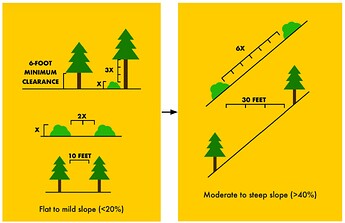Fire likes to move uphill. The National Park Service writes that “if a fire ignites at the bottom of a steep slope, it will spread much more quickly upwards because it can pre-heat the upcoming fuels with rising hot air, and upward drafts are more likely to create spot fires.”
The science
From The science behind fire behavior | South Australia Department for Environment and Water we get more quantitative science:
- "Fire moves faster uphill. In fact, for every 10 degree increase in slope a fire will double in speed. This is because the slope provides a similar effect to the wind, effectively laying the flames down into the slope and pre-heating the vegetation, allowing it to ignite more rapidly.
- Downhill fires slow down up to about 10 degrees on a slope. Beyond that they travel at about 0.6 times the speed of a fire on flat land, regardless of any further increase in slope.
- The aspect of a slope (direction that a sloping piece of land is facing) influences a fire’s [behavior] in a couple of ways; [southern] and western aspects receive more direct heat from the sun, drying the soil and vegetation more than on a southern or eastern slope. Therefore the fuels are usually drier and less dense on [southern] and western slopes than fuels on slopes with a different aspect."
This interesting research study [PDF], from 2007, looks at different explanation for fire speed in slopes, but, interestingly, produces essentially the same results when looking at the rate of spread change with slope:
Looking at the curve, we can see that, for negative slopes, the speed of the fire slows down slightly, then essentially stabilizes. For positive slopes, we can see a 4x speed at 25 degrees, going to 8-10x for 30-35 degrees, increasing to 25-35x for 45 degrees.
Consequences for landscaping
As a result, landscaping on a steep slope needs to follow different, much more conservative principles than on the flat. In particular, spacing plantings on a slope must use significantly wider spread between plants. How does planting distance vary with steepness?
There is a strong consensus among wildfire sites as to how spacing should change with slope. From spacing recommended for flat area, spacing distances should go from 2X height to 4X height (i.e. doubling) when dealing with “moderately steep slopes” of 20-40%, and should go 6X height (i.e. tripling) when dealing with very steep slopes above 40%. Three examples follow.
- CalFire
source: CalFire
CalFire recommends going from 2x height for spacing shrubs and trees in the flat to 6x height for spacing them in a steep slope exceeding 40%, that is, a factor of 3X in increasing spacing.
Do note that the spacing is for trees (or shrubs, for that matter) is between canopies, also called “crowns.” CalFire calls for 10 ft space between canopies in a flat area, and 30 ft space on a very steep hillside.
- UC Marin Master Gardeners
source: UC Master Gardeners
University of California Master Gardeners recommend doubling the recommended 2x spacing on moderate slopes of 20-40%, and tripling it in steep slopes exceeding 40%.
- FireSafe Marin
source: Firesafe Marin
FireSafe Marin has an excellent page on steep slope landscaping. Their recommendation the same: 4x spacing for moderate 20-40% slope, and 6x spacing for steep slopes exceeding 40%. FireSafe Marin also recommends you increase the size of Zone 2 on slopes:
“Push fuel modification area beyond the 100-foot distance, if at all possible. A target for the extended fuel modification area would be between 150 feet and 200 feet.”
So, if your lot is moderately to very steep, make sure to respect very wide spacing practices when landscaping. It could mean the difference between saving your home and seeing it burn.



